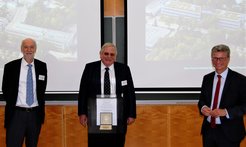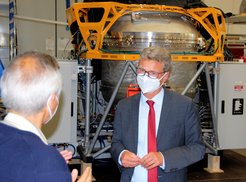Minister of State Bernd Sibler visits MPE
The Bavarian Minister for Science and Arts, Bernd Sibler, visited the Max Planck Institute for Extraterrestrial Physics. In addition to a discussion with the Nobel Laureate and MPE Director Reinhard Genzel, he visited the integration hall and the MICADO laboratory.

At the Max Planck Institute for Extraterrestrial Physics, Bavarian Science Minister Bernd Sibler met with MPE Directors Reinhard Genzel and Ralf Bender and, accompanied by members of the Bavarian State Ministry for Science and the Arts, learned about current research at MPE.
In his overview lecture, Genzel first looked back at the beginnings of the institute, which opened in 1963, and paid tribute to the outstanding importance of the founding father Reimar Lüst, who was to lay the foundation for later cutting-edge research. With that, he drew a bow to today's MPE, referring to countless international cooperations, the IMPRS doctoral school and other success stories such as the eROSITA X-ray space telescope.
According to Genzel, the MPE's goal is to address fundamental questions of modern astronomy and astrophysics with innovative experiments and projects; its success is due to the outstanding teams from the physics and engineering departments, the first-class workshops and the highly motivated young students and postdocs.
Sibler picked up on this idea in his welcoming address. He said it was "simply fascinating" what was being researched and created at institutions like the MPE: "I think a window of opportunity is just opening for their research topics, which are also being noticed by a wider audience."

Another example of groundbreaking technology from the MPE followed promptly: GRAVITY. Project manager Frank Eisenhauer used an animation to illustrate how the instrument works, which combines the four individual telescopes of the Very Large Telescope (VLT) in Chile to create a super telescope, the VLTI. The follow-up project GRAVITY+, which is already in the starting blocks, is intended to take this technology to the next level and thus be able, for example, to measure the mass of black holes in active galactic nuclei over cosmic time and generate high-quality spectra and orbits of exoplanets.
Afterwards, Sibler and his colleagues had the opportunity to see some of the developments at MPE for themselves. In the integration hall, ERIS (Enhanced Resolution Imager and Spectrograph), a next-generation instrument for the VLT in Chile, is waiting to be commissioned, and a look into the MICADO laboratory (Multi-AO Imaging Camera for Deep Observations) showed preparations for the First Light instrument for the Extremely Large Telescope (ELT) currently under construction at the European Southern Observatory ESO. MICADO is to achieve a light sensitivity for point sources comparable to that of the James Webb Space Telescope (JWST), but with a spatial resolution that is better by a factor of 6.













